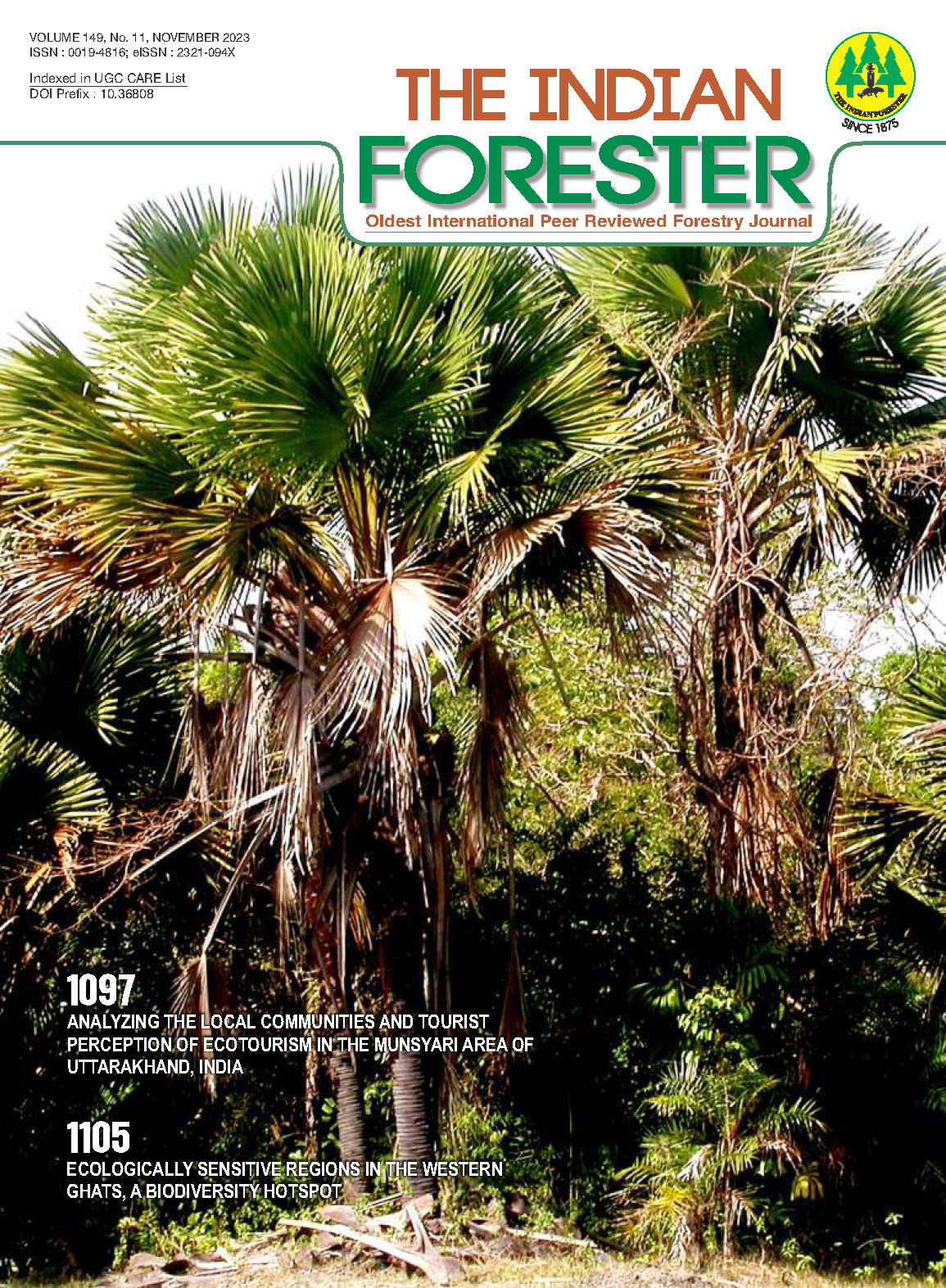Analyzing the Local Communities and Tourist Perception of Ecotourism in the Munsyari Area of Uttarakhand, India
DOI:
https://doi.org/10.36808/if/2023/v149i11/169939Keywords:
Ecotourism, Perception, Recreational Services, Willingness to Pay, Correspondence Analysis.Abstract
Ecotourism, also known as bio-tourism or green tourism, is a responsible travel to pristine areas that helps in the upliftment of locals, heals nature, and maintains social and cultural integrity. Though ecotourism provides a wide array of benefits, it is often argued whether it is a panacea or a predicament. In this study, we tried to assess the perceptions of both locals and tourists regarding ecotourism. A total of 299 tourists and 100 households were surveyed using a structured and semi-structured interview schedule. Results revealed that ecotourism has a positive effect on the local people's income as it provides various employment opportunities, which in turn reduces the out-migration of the locals. Though tourists were overall satisfied with the current scenario in Munsyari, they also raised concerns regarding poor garbage disposal and road facilities. The overall Willingness to Pay for Munsyari visit was around ₹672 per visit and the Willingness to Pay (WTP) has a positive association with awareness of ecotourism. A well-planned and managed ecotourism framework would help locals' well-being, conservation of the environment and meet the needs of tourists.References
Adie B.A., Falk M. and Savioli M. (2020). Overtourism as a perceived threat to cultural heritage in Europe. Current Issues in Tourism, 23(14): 1737-1741.
Afroz N. and Mahmud S. (2017). Analyzing the problem and prospects of Ecotourism: A review on Bangladesh. Journal of business and management, 19: 59-65.
Ahsan N. (2008). Ecotourism in Bangladesh: a new tool for economic development. Journal of socio-economic research and development, 5(3): 299-304.
Anup K.C. (2017). Ecotourism in Nepal. The Gaze: Journal of Tourism and Hospitality, 8: 1-19.
Boley B.B. and Green G.T. (2016). Ecotourism and natural resource conservation: the 'potential' for a sustainable symbiotic relationship. Journal of Ecotourism, 15(1): 36-50.
Brandt J.S. and Buckley R.C. (2018). A global systematic review of empirical evidence of ecotourism impacts on forests in biodiversity hotspots. Current Opinion in Environmental Sustainability, 32: 112-118.
Deng J., King B. and Bauer T. (2002). Evaluating natural attractions for tourism. Annals of Tourism Research, 29: 422-438.
Duroy Q.M. (2005). The determinants of environmental awareness and behavior. Journal of Environment and Development, 1-26.
Fennel D.(2015).Ecotourism:An Introduction,(4th ed). Routledge, London.
Florina B.R.A.N., Alpopi C. and Burlacu S. (2018). Territorial development-disparities between the developed and the least developed areas of Romania. LUMEN Proceedings, 6(1): 146-155.
Gössling S. (1999). Ecotourism: a means to safeguard biodiversity and ecosystem functions?. Ecological economics, 29(2): 303-320.
He S., Gallagher L., Su Y., Wang L. and Cheng H. (2018). Identification and assessment of ecosystem services for protected area planning: A case in rural communities of Wuyishan national park pilot. Ecosystem Services, 31: 169-180.
Herath G. (2002). Research methodologies for planning ecotourism and nature conservation. Tourism economics, 8(1): 77-101.
Jalani J. (2012). Local people's perception on the impacts and importance of ecotourism in Sabang, Palawan, Philippines. Social and Behavioral Sciences, 57(2012): 247 – 254.
Karwacki J. and Boyd C. (1995). Ethics and ecotourism. Business Ethics: AEuropean Review, 4(4): 225-232.
Keul A. and Kühberger A. (1997). Tracking the Salzburg tourist. Annals of Tourism Research, 24(4): 1008-1012.
Khan I., Lei H., Ali G., Ali S. and Zhao M. (2019). Public attitudes, preferences and willingness to pay for river ecosystem services. International Journal of Environmental Research and Public Health, 16(19): 3707.
Khayrulloevna A.M. (2020). The substantial economic benefits of tourism. Academy, 3(54): 39-40.
NIC of Pithoragarh. (2022). District at a glance 2021, Dehradun, Government of India. Retrieved from District Pithoragarh, Government of Uttarakhand | District Pithoragarh, Government of Uttarakhand|A Kailash Mansarovar district | India | IndiaAccessed on 1/07/2022
Park S., Woo M. and Nicolau J.L. (2020). Determinant factors of tourist expenses. Journal of Travel Research, 59(2): 267-280.
Rahimzadeh A. (2016). Mountain Livelihoods in Transition: Constraints and Opportunities in Kinnaur, Western Himalaya (Doctoral dissertation, UC Berkeley). Rahimzadeh, A. (2016). Mountain Livelihoods in Transition: Constraints and Opportunities in Kinnaur, Western Himalaya (Doctoral dissertation, UC Berkeley).
Ross S. and Wall G. (1999). Ecotourism: towards congruence between theory and practice. Tourism management, 20(1): 123-132.
Sahani A.K. (2021). Eco-Tourism: An Option for Sustainable Livelihood in Uttarakhand to Reduce Out Migration. Journal of Tourism Research & Hospitality, 10:7.
Scheyvens R. (2010). Promoting Women's Empowerment Through Involvement in Ecotourism: Experiences from the Third World. Journal of Ssustainable Ttourism, 8: 232- 249.
Sindhu D. and Singh D. (2014). Ecotourism and Local Perception about its Impacts a Study of Village Sam, Jaisalmer, Rajasthan. International Journal of Environment, Ecology, Family and Urban Studies (IJEEFUS), 4(6): 1-6.
Singh B.P. and Upadhyay R. (2011). Ecotourism and its effects on wildlife of Pachmarhi Biosphere Reserve. African Journal of Environmental Science and Technology, 5(9): 717-721.
Stronza A.L., Hunt C.A. and Fitzgerald L.A. (2019). Ecotourism for conservation? Annual Review of Environment and Resources, 44: 229-253.
Tripathi K. (2016). Tourism to ecotourism: a tour. International Journal of Humanities and Social Science, 12: 27-30.
Vespestad M.K. and Mehmetoglu M. (2015). Gender differences in vacation behavior. Tourism Review International, 19(3): 147-161.
Vujko A., Petrović M.D., Gostović D., Radovanović M. and Vuković D. (2018). The Role of Natural Resources in the Ecotourism Development—Residents' Perceptions in Subotica (Northern Serbia). Deturope, 10: 112– 123.
Xu S., Mingzhu L., Bu N. and Pan S. (2017). Regulatory frameworks for ecotourism: An application of total relationship flow management theorems.Tourism Management,61:321-330.
Downloads
Downloads
Published
How to Cite
Issue
Section
License
Unless otherwise stated, copyright or similar rights in all materials presented on the site, including graphical images, are owned by Indian Forester.





